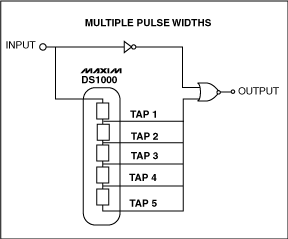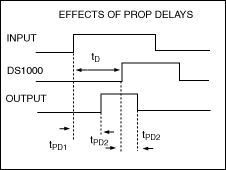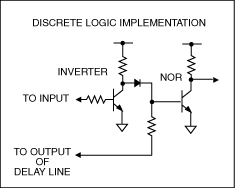
Some external logic can be combined with a delay line to implement a one-shot function. This approach has the advantage that it eliminates the need for RC timing components and can offer improved accuracy.

If a tapped delay line is used, it can be combined with a multiplexer, DIP switches, or jumpers to offer several different output pulse widths, under system control or hard-wired.

The realizable accuracy will be determined by how the logic is implemented and the associated propagation delays through it compared to the chosen delay time. Ideally, the external propagation delays should be small compared to the delay time, in which case the output pulse width will be close to the delay time used.
The various propagation delays have the following effects on overall system performance: the inverter propagation delay (tPD1) directly affects the output pulse width; the NOR gate propagation delay (tPD2), in conjunction with the inverter propagation delay, will affect the skew between input and output.

TTL logic, although easy to implement, suffers from relatively large propagation delays depending on family, (e.g., LS, FAST) and from wide tolerances at room temperature and over the operating range. For shorter pulse widths and tighter tolerance, it may be preferable to implement the function using discrete transistors (RTL).

One member of the Silicon Timed Circuit family, the DS1040 preconfigured as a one-shot, and offers similar functionality without requiring external components.
欢迎分享,转载请注明来源:内存溢出

 微信扫一扫
微信扫一扫
 支付宝扫一扫
支付宝扫一扫
评论列表(0条)